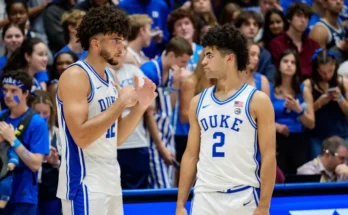Alabama football is incapable of hosting a legitimate spring game.
For most college football programs, the annual spring game serves as a vital benchmark—a chance for fans to see the team’s early identity, for coaches to evaluate position battles, and for players to perform under a semblance of game-day pressure. But at Alabama, the spring game has devolved into something far less useful. Despite being one of the most storied and well-resourced programs in college football history, Alabama has repeatedly failed to offer fans and analysts a true football simulation during its A-Day spring showcase. And with the transition from the Nick Saban era to the Kalen DeBoer era, that issue has only magnified.
A Once-Mighty Tradition Watered Down
There was a time when A-Day was treated with reverence. Saban famously drew over 92,000 fans to Bryant-Denny Stadium in 2007 during his first spring game as Alabama’s head coach. The energy was electric, and the performance on the field mattered. It set a tone not just for the players, but for the fan base and the national media. But fast forward to the last few years, and the tone has shifted dramatically.
Attendance is down. Competitive spirit is lacking. And worse yet, the format has become unwatchable, particularly for those hoping to evaluate real progress. Alabama’s spring game has turned into a glorified practice with vanilla schemes, limited hitting, and bizarre rules that remove the tension from key situations.
The Quarterback Carousel is a Prime Example
Perhaps nowhere is the dysfunction more evident than at quarterback. Last year’s A-Day game was supposed to give clarity between Jalen Milroe, Ty Simpson, and Notre Dame transfer Tyler Buchner. Instead, it did the opposite.
All three quarterbacks played behind shuffled offensive lines, with limited play-calling, and virtually no sense of rhythm. There were no downfield shots, no trick plays, no real game-speed tempo—just heavily scripted drives designed to avoid injury and controversy. Milroe completed fewer than 50% of his passes. Simpson wasn’t much better. Buchner looked lost. Rather than helping fans or coaches feel confident in the depth chart, the game deepened confusion.
And that has become a pattern at Alabama: The spring game tells you next to nothing about the quarterback race—or any other position battle, for that matter.
Fear of Injury Trumps Competitive Reps
There’s one obvious reason Alabama has softened its spring game: the risk of injury. And that fear isn’t without merit. Losing a key player in a meaningless April scrimmage can wreck an offseason. But while it’s understandable to be cautious, Alabama has swung too far in the other direction.
Rather than creating competitive, controlled chaos, the staff has resorted to flag football principles. Quarterbacks are off-limits to contact. Tackling is limited to certain periods. Blitzes are often banned or heavily restricted. And in recent years, some players—especially stars—don’t even participate. It’s hard to get better in that environment. It’s even harder to evaluate who is getting better.
The Format Has Become a Joke
Every year, Alabama tinkers with the A-Day format in ways that make less sense. One team has starters, the other doesn’t. Defensive scoring is based on arbitrary systems. Game flow is constantly interrupted by situational drills. This Frankenstein’s monster of a format may work for internal film review, but it’s a disaster from a football perspective.
In 2023, the scoring system was so convoluted that fans in the stadium had no idea what the score was. Coaches awarded points for “stops,” “turnovers,” and other invisible stats. The result? A game with no rhythm, no narrative arc, and no stakes. That’s not football. That’s data collection masquerading as sport.
It’s a Missed Opportunity for the DeBoer Era
Now with Kalen DeBoer taking over, Alabama had a chance to reimagine A-Day as something that matters again. After all, DeBoer is a brilliant offensive mind who revitalized Washington with an electric passing game. Fans were eager to see how his system would translate to SEC speed. But instead of a showcase, A-Day 2025 was more of the same: tight playbooks, lopsided rosters, and an intentional lack of drama.
It was the perfect opportunity to let new quarterback Jalen Milroe—or his challengers—run DeBoer’s full playbook in front of a crowd. It was the right moment to show how new coordinators and transfers were fitting in. Instead, fans left wondering whether Alabama is hiding its cards or simply hasn’t figured anything out yet.
Other Programs Do It Better
And perhaps most damning of all is this: other top programs manage to host exciting, useful spring games without catastrophic results.
Take Georgia, for example. Kirby Smart has taken a similar approach to Saban in many ways, but his spring games still offer a glimpse into the quarterback room, offensive shifts, and team cohesion. Fans watch because they’ll see something real—even if vanilla.
Or look at USC. Under Lincoln Riley, the Trojans use their spring game to showcase explosive plays and offensive rhythm. Texas treats theirs like a real event, with media access, full rosters, and something close to game speed. Even newer programs like Colorado, under Deion Sanders, are using spring games to build brand identity.
So why can’t Alabama?
Alabama’s Fan Base Deserves Better
Nobody is asking for a full-contact, 70-play slugfest with first-team starters playing into the fourth quarter. But the current product isn’t worth the hype it receives. The Alabama fan base is one of the most passionate and loyal in the nation. They deserve more than a controlled scrimmage where the outcome is predetermined and the performances are sanitized.
A-Day should be an opportunity to connect with the team—not just through autographs and atmosphere, but through football. Watching backups go through half-speed drills with limited play variety isn’t inspiring. It’s a waste of time.
What Needs to Change
To reclaim relevance, Alabama’s spring game needs a complete overhaul. Here’s how:
- Balance the Rosters – Create two evenly matched teams with a true draft system or clear first-team vs. second-team format. Don’t stack the depth chart just to avoid competition.
- Simplify the Rules – Scrap the confusing scoring systems and return to traditional football rules. Let the game flow naturally.
- Open Up the Playbook – Let fans see elements of the new schemes. A few deep shots, some play-action, and situational drives can go a long way.
- Create Stakes – Incentivize competition with rewards. Maybe the winning team gets steak, the losers eat beans. That concept used to work and brought energy to the field.
- Improve Broadcast Quality – The spring game isn’t just for the 30,000 in attendance. Many more watch online or on TV. Invest in better production, graphics, and analysis.
- Make the QBs Compete – Stop protecting players from pressure. Quarterbacks need to feel urgency. Even if they wear no-contact jerseys, force them to make real-time decisions.
The Bottom Line
For a program that prides itself on “The Process,” Alabama’s current spring game approach feels lazy. It’s a byproduct of a dynasty so dominant that spring stopped mattering. But in the post-Saban world, everything matters again. The margins are thinner. The talent gap has closed. And every opportunity to improve or evaluate must be seized.
A-Day should be more than just a checkpoint. It should be a show. A measuring stick. A celebration of what’s coming.
Right now, it’s none of those things.
Until Alabama commits to hosting a legitimate spring game—one that resembles football and rewards fans for their loyalty—the program risks losing touch with the very foundation of its success: competition.
And in the SEC, where every edge counts, that’s a risk Alabama can no longer afford.



